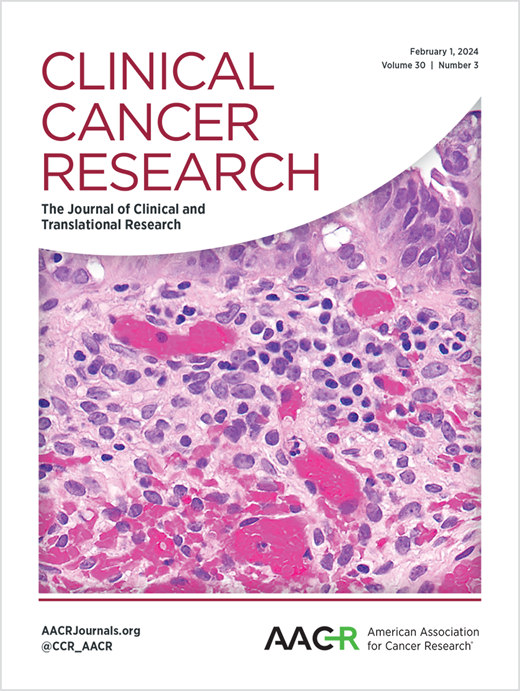癫痫发作相关同源蛋白6靶向抗体-药物共轭物ABBV-011在小细胞肺癌患者中的I期首次人体试验研究
IF 10
1区 医学
Q1 ONCOLOGY
引用次数: 0
摘要
目的:癫痫发作相关同源蛋白6(SEZ6)是在小细胞肺癌(SCLC)中表达的一种新靶点。ABBV-011是一种与卡利昔明结合的SEZ6靶向抗体,在复发/难治性SCLC患者的I期研究(NCT03639194)中进行了评估。我们报告了ABBV-011单药治疗的初步结果。患者和方法:在剂量递增(0.3-2 mg/kg)和扩增期间,ABBV-011每3周(Q3W)静脉给药一次。预选SEZ6阳性肿瘤患者(免疫组化染色强度≥1+的肿瘤细胞≥25%)进行扩增。对其安全性、耐受性、抗肿瘤活性和药代动力学进行了评估。结果:截至2022年8月,99名患者接受了ABBV-011单药治疗(剂量升级,36人;日本剂量评估,3人;剂量扩大,60人[1毫克/千克,40人]);中位年龄为63岁(41-79岁)。32%、41%和26%的患者之前分别接受过1次、2次和≥3次治疗。最大耐受剂量未达到 2.0 毫克/千克。最常见的治疗突发不良事件(TEAE)是疲劳(50%)、恶心(42%)和血小板减少(41%)。最常见的肝脏 TEAE 为天冬氨酸氨基转移酶升高(22%)、谷氨酰转移酶升高(21%)和高胆红素血症(17%);2 名患者出现静脉闭塞性肝病。客观反应率(ORR)为 19%(19/98)。在1毫克/千克剂量扩大队列(40人)中,ORR为25%;中位反应持续时间为4.2个月(95% CI,2.6-6.7),中位无进展生存期为3.5个月(95% CI,1.5-4.2)。结论ABBV-011 1.0 mg/kg Q3W单药治疗耐受性良好,在重症复发/难治性SCLC患者中表现出令人鼓舞的抗肿瘤活性。SEZ6是一个很有前景的新型SCLC靶点,值得进一步研究。本文章由计算机程序翻译,如有差异,请以英文原文为准。
A Phase I First-in-Human Study of ABBV-011, a Seizure-Related Homolog Protein 6-Targeting Antibody-Drug Conjugate, in Patients With Small Cell Lung Cancer
Purpose: Seizure-related homolog protein 6 (SEZ6) is a novel target expressed in small cell lung cancer (SCLC). ABBV-011, a SEZ6-targeted antibody conjugated to calicheamicin, was evaluated in a phase I study (NCT03639194) in patients with relapsed/refractory SCLC. We report initial outcomes of ABBV-011 monotherapy. Patients and Methods: ABBV-011 was administered intravenously once every 3 weeks (Q3W) during dose escalation (0.3–2 mg/kg) and expansion. Patients with SEZ6-positive tumors (≥25% of tumor cells with ≥1+ staining intensity by immunohistochemistry) were preselected for expansion. Safety, tolerability, antitumor activity, and pharmacokinetics were evaluated. Results: As of August 2022, 99 patients received ABBV-011 monotherapy (dose escalation, n=36; Japanese dose evaluation, n=3; dose expansion, n=60 [1 mg/kg, n=40]); median age was 63 years (range, 41–79). Thirty-two percent, 41%, and 26% of patients received 1, 2, and ≥3 prior therapies, respectively. The maximum tolerated dose was not reached through 2.0 mg/kg. Most common treatment-emergent adverse events (TEAEs) were fatigue (50%), nausea (42%), and thrombocytopenia (41%). Most common hepatic TEAEs were increased aspartate aminotransferase (22%), increased g-glutamyltransferase (21%), and hyperbilirubinemia (17%); 2 patients experienced veno-occlusive liver disease. Objective response rate (ORR) was 19% (19/98). In the 1-mg/kg dose-expansion cohort (n=40), ORR was 25%; median response duration was 4.2 months (95% CI, 2.6–6.7) and median progression-free survival was 3.5 months (95% CI, 1.5–4.2). Conclusions: ABBV-011 1.0 mg/kg Q3W monotherapy was well tolerated and demonstrated encouraging antitumor activity in heavily pretreated patients with relapsed/refractory SCLC. SEZ6 is a promising novel SCLC target and warrants further investigation.
求助全文
通过发布文献求助,成功后即可免费获取论文全文。
去求助
来源期刊

Clinical Cancer Research
医学-肿瘤学
CiteScore
20.10
自引率
1.70%
发文量
1207
审稿时长
2.1 months
期刊介绍:
Clinical Cancer Research is a journal focusing on groundbreaking research in cancer, specifically in the areas where the laboratory and the clinic intersect. Our primary interest lies in clinical trials that investigate novel treatments, accompanied by research on pharmacology, molecular alterations, and biomarkers that can predict response or resistance to these treatments. Furthermore, we prioritize laboratory and animal studies that explore new drugs and targeted agents with the potential to advance to clinical trials. We also encourage research on targetable mechanisms of cancer development, progression, and metastasis.
 求助内容:
求助内容: 应助结果提醒方式:
应助结果提醒方式:


